Are you ready? It’s hop harvest time! Here’s how I harvest my homegrown hop crop. I also show how I process and store them to use later. What do I use my hops for? Brewing beer, hop chocolate, hop tea, hop mac & cheese, and even more. But first we have to hop to it and get to picking!
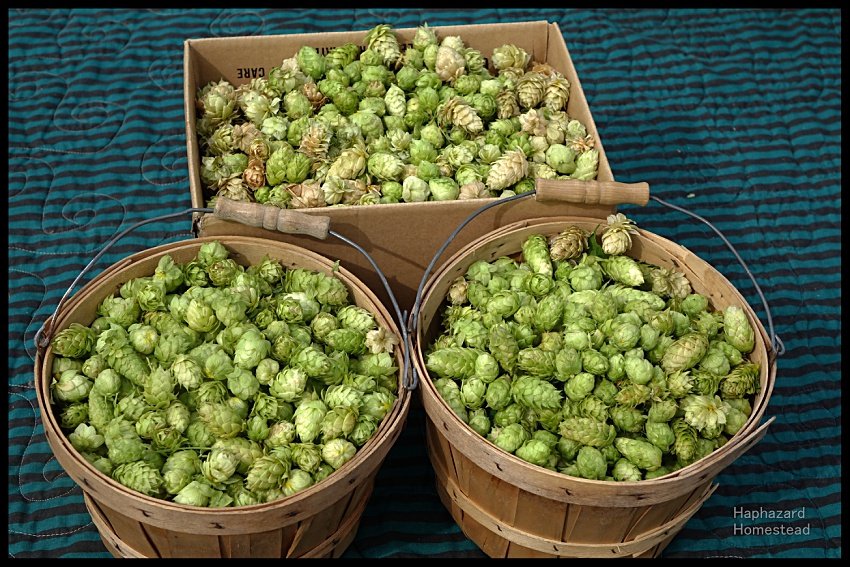
Verification: These are my own original photos based on my 2015 harvest. You can verify me by going to my YouTube video on hop harvesting and check in the video description for a statement that I have a blog on Steemit. Feel free to say howdy from a Steemit user in the comments to any of my videos and subscribe to my channel.
Picking Hops
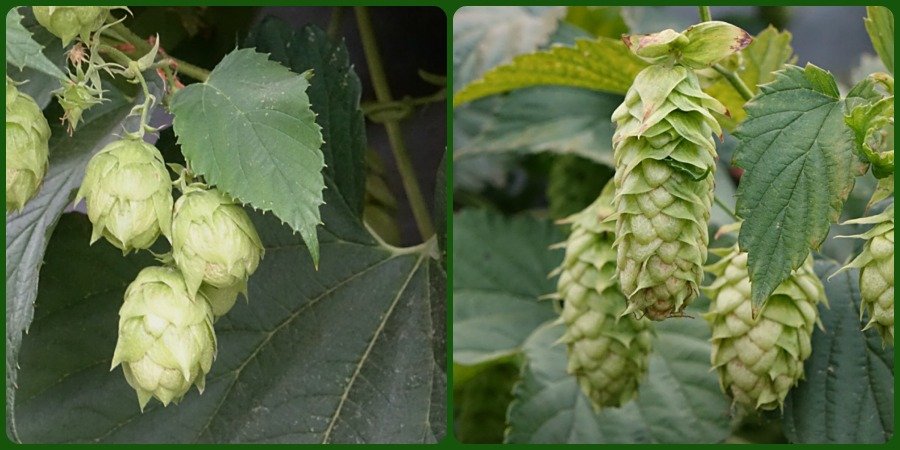
How Can I Tell When It’s Time to Pick Hops?
As the summer comes to an end, I check on my hop flowers. Hop flowers look like little pine cones. They are even called hop cones, but they are flowers - the mature seedhead of the female flowers. There won’t be any seeds unless there is a male hop plant around, and those are hard to come by.
If the hop flowers are green and tight, I leave them alone. I’m waiting until the hop cones become light, dry, like parchment. I’m waiting until they spring back to their original shape when I lightly compress them between my fingers. Then then they are ready to pick.
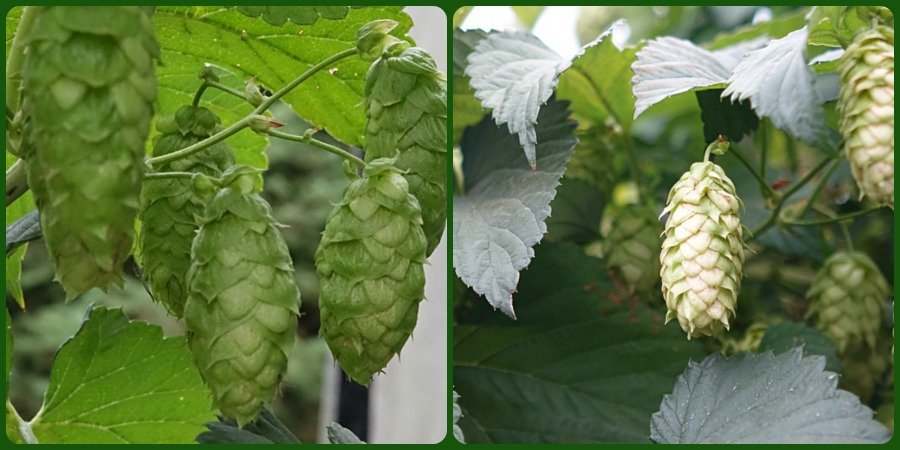
What Am I Harvesting?
It's not the hop cone that I'm really after in my harvest. I’m after the oils and resins hidden with each flower. But the only way to get that is to pick the whole hop cone.
When the hop resin in the flowers is a pretty yellow-gold, it’s time to get to picking! Some folks are adamant that it's better to pick hops too early than too late. But other folks have had fine results using even the brown hops as long as the resin is yellow and smells good.
I have had no trouble with hops that have turned brown, as long as the weather has been dry and only warm, not hot, like in the 90s (F). But if the weather is forecast to be wet, I get out and harvest everything. Wet hops are not top hops – wet hops rot.
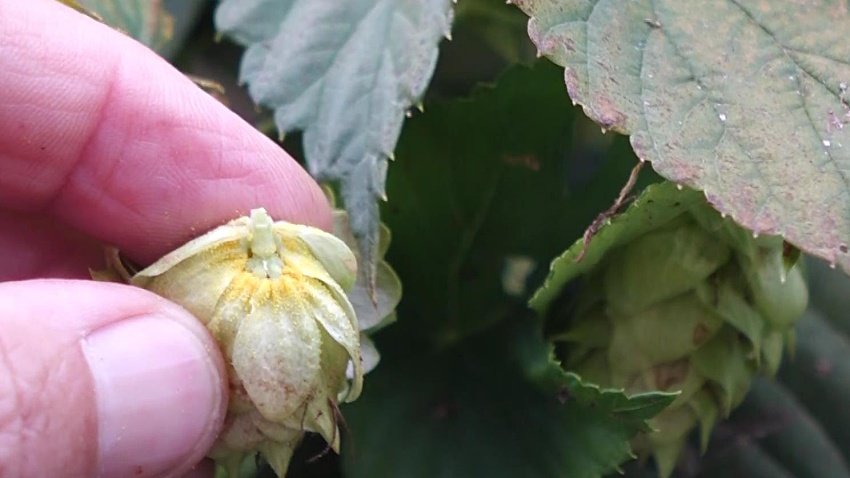
How Do Hops Grow?
Hops are absolute monsters of the plant world – they grow fast and they grow a lot! They will grow over anything that is around them and their roots will spread runners underground to expand their territory.
Commercial hop growers and good gardeners grow their hops on tall supports that let the plant reach its full potential of 20 to 25 feet of growth in just a few months. Even after more than a decade, I still haven’t built my hops such a nice setup. They do fine growing in a larger mass on a 7-foot high trellis system.
Technically, hops are not a vine, but a bine because they don’t have tendrils or thorns. Instead, they climb by constricting around their support like a boa constrictor.
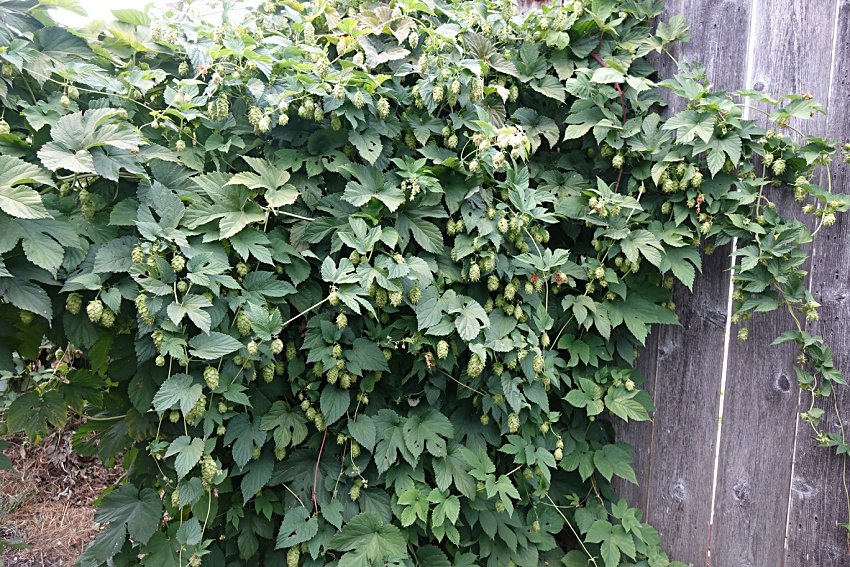
How Do I Pick Hop Cones?
Commercial hop growers cut their hop bines all the way down to the ground and haul them into a big processing center. But I like to leave my vines standing until winter because they are pretty and I have a lot of other homestead projects going in the fall. So I don’t cut my hop bines down to ground level until the winter.
That means I pick my hop cones out where they grow. Hops have scratchy hairs on their vines and some people are really sensitive to that. I wear long sleeves to keep from getting all cut up by the vines.
I use my camping cookpot tied to a cord and hang that from my neck to make picking efficient. Then I dump each cookpot load into baskets. It would be a lot harder to pick if my hop vines were 25 feet tall. But then I would just cut them down and pick at my leisure in the shade. But with my short hops, I can pick easily. So I guess there is a bonus for being haphazard!
Can I Eat Hops While I Pick?
Do you have trouble eating too many strawberries, blackberries, or other fruits and vegetables while you are picking them? Picking hops is great for learning to NOT eat what you are picking. They are so bitter! They make even bitter dandelions seem sweet by comparison!
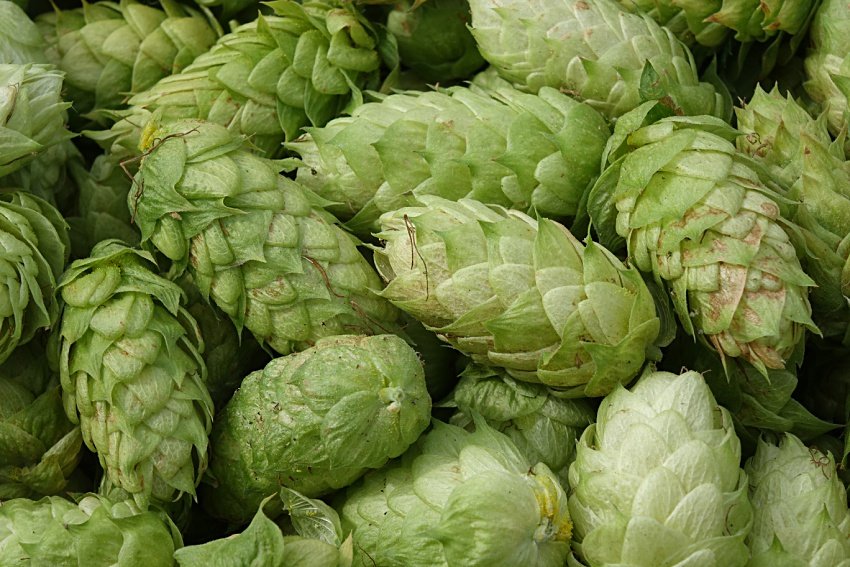
Processing Hops
What’s the Reason for Drying Hops?
Once the hops are picked, you can’t waste any time in getting them processed for storage. You have got to hop on it! The goal in storing hops is to keep their oils and resins stable. The short-term enemies are heat and oxidation. The first step is to get the hops cones dry!
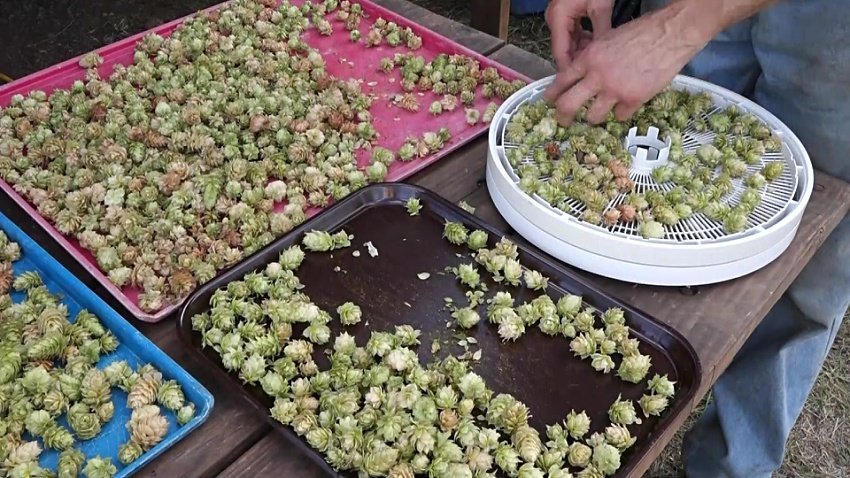
Can I Dry Hops Without A Lot of Equipment?
I put my hops cones on big trays to dry. That works fine when we have cool, dry weather. Big window screens work even better. But here in Oregon’s Willamette Valley, my hops often are ready just when our fall rains return. In that case, air drying isn't quite enough to dry the hop cones down all the way. I have to transfer the hop cones to some dehydrator trays to finish drying them down.
Commercial hop dryers may go up to 140 degrees Fahrenheit, but I keep my dehydrators set to about 105 degrees Fahrenheit and let them go for a day or two. My goal is to dry them without heating the oils and resins.
When Are My Hops Are Dry Enough?
I check my hop cones after at least 24 hours. The center stem of the hop cone should be brittle and break apart when it's bent. The entire hop cone should be crispy. It doesn’t have to fall apart when it’s handled, but it should stay crushed when it’s compressed.

Storing Hops
How Long Will Hops Keep?
Once my hops are dried, I have to do something to keep the oils and resins from oxidizing. The long-term enemies are heat, oxygen, and light. If I just put them loosely in a jar on my kitchen counter, they will lose a lot of their great smell within even a month. They can even go rancid. And nobody wants rancid hops! So my hop harvest still isn’t over. I have to keep hopping and get them in long-term storage.
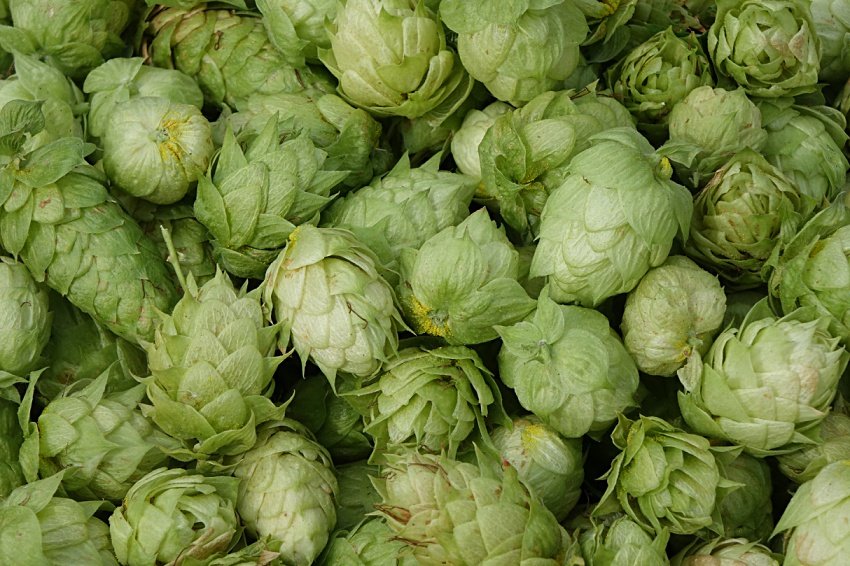
Where Do I Keep My Hops?
I keep my hops the freezer. That's right, the freezer! The freezer is great for keeping the hop oils and resins cold and in the dark. But I have to work to keep their oxygen exposure low. If I vacuum packed my hops and put them in the freezer, they keep great for at least 18 months. They probably will be fine even two or three years later, although I haven’t tested the limits of the vacuum packs.
My approach is low tech because I don’t have a vacuum machine. I store my hops in canning jars and put the jars in the freezer. I do keep some jars of my hops in my old, double-walled pumphouse that covers my irrigation well and, like a root cellar, holds all my jars of homegrown and foraged produce that I preserve. But I use those hops pretty quickly, during the winter and certainly by the next year.
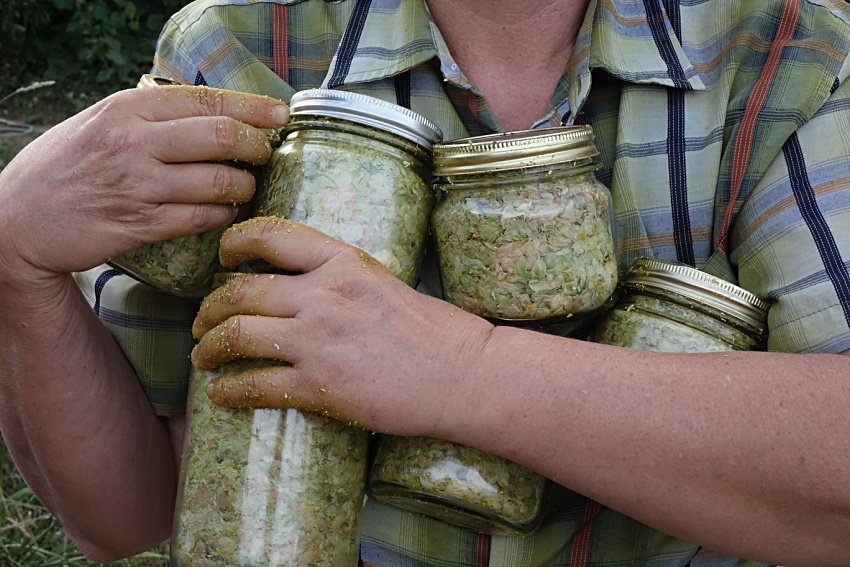
How Do I Can My Hops?
I’m trying to avoid exposing the hops to the air while they are in the freezer or my pumphouse. So I need to get as much air as I can out of the jars. I don't want to vacuum pack the hops with the heat of a canner.
Commercial hop operations compress their dried hops into big bales. I just compress my hops directly into the jar. The more hops I get in the jar, the less air can be in there. So I keep stuffing hops into each jar until I can’t fit any more in. I use a cutout circle from a yogurt or cottage cheese lid to compress my hops down into the jar.
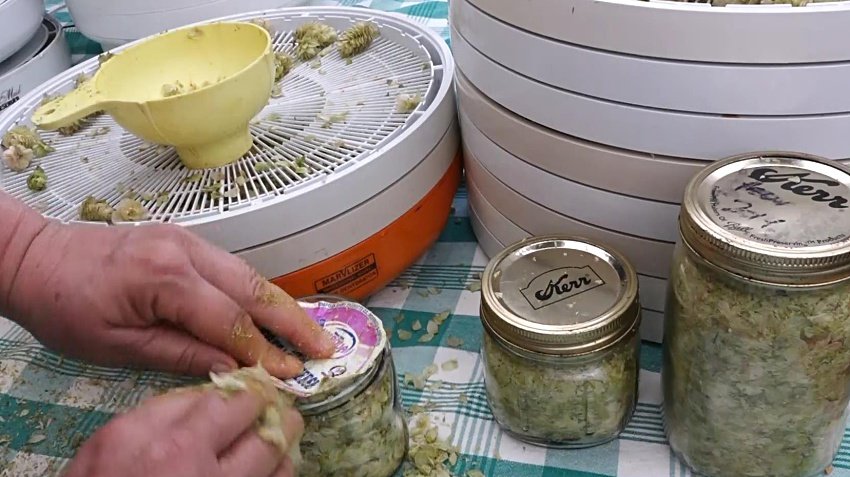
How Do I Clean Up My Hop Processing Mess?
That all important hop resin is super sticky! So everything it touches – the dehydrator tray, other tools, and my hands – have to be washed well before they get used for anything else. Thankfully, the resin is easily cleaned up with hot water and soap.
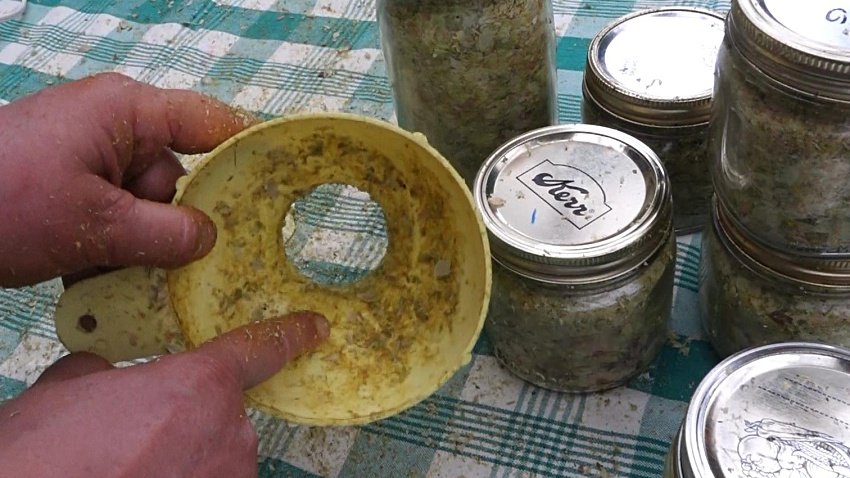
Using Hops
I use my hops for a bunch of different things. In brewing beer at home, a lot of people buy hop pellets and pick out specific varieties for either their aromatic qualities or their bittering qualities. My hops are “dual use, whole leaf hops”.
I’m partial to using hops for brewing beer. But they I use them for a lot more, too! I really like Hop Tea. And hops make even cheap hot chocolate packets into a nice Hop Chocolate with IPA-lovers will appreciate. Hop soda and hop popsicles are good. I cook with hops, too – hop macaroni and cheese, and a little bit in with a stew or roast, and more. And a little hop sack makes for great sleeping.
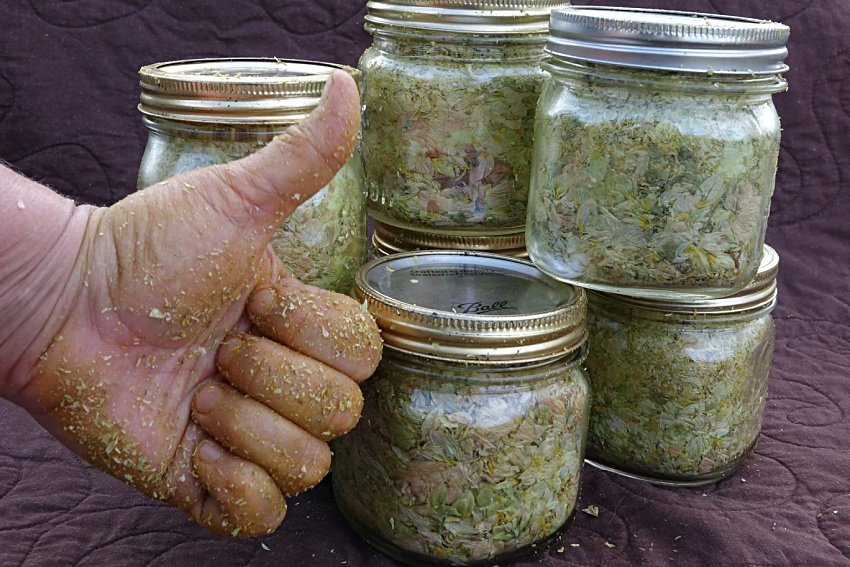
Want to See More Hops Posts?
I’ll be posting more on growing and using hops. And I harvest an entirely different hop crop in the spring! So be sure to follow me, if you don’t want to miss seeing any of those posts in your feed.
foraging, gardening, nature, simple living close to the land

